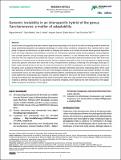Por favor, use este identificador para citar o enlazar a este item:
http://hdl.handle.net/10261/222204COMPARTIR / EXPORTAR:
 SHARE SHARE
 CORE
BASE CORE
BASE
|
|
| Visualizar otros formatos: MARC | Dublin Core | RDF | ORE | MODS | METS | DIDL | DATACITE | |

| Título: | Genomic instability in an interspecific hybrid of the genus Saccharomyces: a matter of adaptability |
Autor: | Morard Pedrouzo, Miguel ; Ibáñez, Clara CSIC; Adam, Ana Cristina CSIC ORCID; Querol, Amparo CSIC ORCID; Barrio, Eladio CSIC ORCID; Toft, Christina CSIC ORCID | Palabras clave: | Adaptation Genome instability Hybrids Resequencing Saccharomyces cerevisiae Saccharomyces kudriavzevii |
Fecha de publicación: | 6-oct-2020 | Editor: | Microbiology Society | Citación: | Microbial genomics 6(10) https://doi.org/10.1099/mgen.0.000448 (2020) | Resumen: | Ancient events of polyploidy have been linked to huge evolutionary leaps in the tree of life, while increasing evidence shows that newly established polyploids have adaptive advantages in certain stress conditions compared to their relatives with a lower ploidy. The genus Saccharomyces is a good model for studying such events, as it contains an ancient whole-genome duplication event and many sequenced Saccharomyces cerevisiae are, evolutionary speaking, newly formed polyploids. Many polyploids have unstable genomes and go through large genome erosions; however, it is still unknown what mechanisms govern this reduction. Here, we sequenced and studied the natural S. cerevisiae × Saccharomyces kudriavzevii hybrid strain, VIN7, which was selected for its commercial use in the wine industry. The most singular observation is that its nuclear genome is highly unstable and drastic genomic alterations were observed in only a few generations, leading to a widening of its phenotypic landscape. To better understand what leads to the loss of certain chromosomes in the VIN7 cell population, we looked for genetic features of the genes, such as physical interactions, complex formation, epistatic interactions and stress responding genes, which could have beneficial or detrimental effects on the cell if their dosage is altered by a chromosomal copy number variation. The three chromosomes lost in our VIN7 population showed different patterns, indicating that multiple factors could explain the mechanisms behind the chromosomal loss. However, one common feature for two out of the three chromosomes is that they are among the smallest ones. We hypothesize that small chromosomes alter their copy numbers more frequently as a low number of genes is affected, meaning that it is a by-product of genome instability, which might be the chief driving force of the adaptability and genome architecture of this hybrid. | Versión del editor: | https://doi.org/10.1099/mgen.0.000448 | URI: | http://hdl.handle.net/10261/222204 | DOI: | 10.1099/mgen.0.000448 | E-ISSN: | 2057-5858 |
| Aparece en las colecciones: | (IATA) Artículos |
Ficheros en este ítem:
| Fichero | Descripción | Tamaño | Formato | |
|---|---|---|---|---|
| mgen000448.pdf | Artículo principal | 2,3 MB | Adobe PDF |  Visualizar/Abrir |
CORE Recommender
PubMed Central
Citations
4
checked on 10-abr-2024
SCOPUSTM
Citations
5
checked on 15-abr-2024
WEB OF SCIENCETM
Citations
5
checked on 25-feb-2024
Page view(s)
186
checked on 19-abr-2024
Download(s)
239
checked on 19-abr-2024

